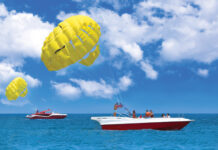By Drew Lewis, Beach Mosquito Control District’s Pilot
In short, not much! An argument could be made that both share an exoskeleton (and both fly) but that is where the list of similarities would end. However, helicopters and other aircraft are often used in mosquito abatement practices.
Borrowing heavily from the equipment and techniques used in aerial agricultural applications, mosquito control organizations often use helicopters to manage mosquito populations. Beach Mosquito Control District (BMCD) is responsible for managing mosquito populations in Panama City Beach and primarily uses helicopters in three ways; to control flying adult mosquitos (adulticide), to control their larval and pupal stage (larvicide) prior to their metamorphosis into the flying, biting nuisance, and reconnaissance.
When it comes to reconnaissance, helicopters are excellent tools for finding things like new areas of standing water or slimy green, neglected swimming pools. If you see me circling overhead on a summer afternoon, it is likely a reconnaissance mission.
Larvicide can be tricky because it must be executed at the site where the larvae live. Our trucks cannot reach many of the swampy areas where mosquitos prosper simply because of the lack of roads. This is where helicopters come in handy. From the air, we can dispense a granular material that is able to penetrate the tree canopy and get straight to work on the larvae by halting their metamorphosis. If you have ever purchased mosquito pucks or dunks to throw in your pond or backyard ditch, that is basically the same thing. After a series of rain showers where we may have days or weeks with lots of standing water, the mosquito populations can spike. Helicopters can be particularly effective in larvicide efforts during these times because we can quickly treat large and inaccessible areas.
Adulticide has its own challenges. To combat flying mosquitos, we need to catch them while they are active. This is best done in the hours after sunset. While flying with night vision goggles, we dispense a liquid chemical at extremely low volumes (less than two-thirds of an ounce per acre) that is designed to target adult mosquitos without harming anything else. The helicopter is configured with high-tech equipment to atomize the chemical to the perfect size and track applications to precise degrees. This very fine atomization is designed to allow the chemical to drift out into a swath that is approximately 1000 feet wide. This type of application is extremely effective in treating large areas very quickly.
When do we fly adulticide or larvicide missions? In short, when it is most effective. In addition, the Environmental Protection Agency (EPA) regulates all chemicals that we use and helps give us guidelines on when and how to apply them. These guidelines are designed to keep us all safe, as well as the environment around us that contains other sensitive critters like Honeybees. Our surveillance team traps and monitors mosquito “counts” to determine when populations might be spiking. The BMCD team also monitors mosquito-borne virus activity, such as West Nile and several forms of encephalitis, by regularly testing several flocks of chickens that we maintain at strategic sites around the district. If population counts start spiking or if we detect abnormal levels of virus activity, that’s our cue to launch an adulticide mission via helicopter.
We do our best to stay safe in all aspects of our operation. So, if you hear me buzz over your house at an altitude that sounds a little lower than normal air traffic, I am just trying to make sure the mosquitos are not buzzing over you, too.

















































